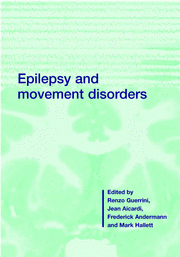Book contents
- Frontmatter
- Contents
- List of contributors
- Preface and overview
- 1 Epilepsies as channelopathies
- 2 Epilepsy and movement disorders in the GABAA receptor β3 subunit knockout mouse: model of Angelman syndrome
- 3 Genetic reflex epilepsy from chicken to man: relations between genetic reflex epilepsy and movement disorders
- 4 Functional MRI of the motor cortex
- 5 Neuromagnetic methods and transcranial magnetic stimulation for testing sensorimotor cortex excitability
- 6 Motor dysfunction resulting from epileptic activity involving the sensorimotor cortex
- 7 Nocturnal frontal lobe epilepsy
- 8 Motor cortex hyperexcitability in dystonia
- 9 The paroxysmal dyskinesias
- 10 Normal startle and startle-induced epileptic seizures
- 11 Hyperekplexia: genetics and culture-bound stimulus-induced disorders
- 12 Myoclonus and epilepsy
- 13 The spectrum of epilepsy and movement disorders in EPC
- 14 Seizures, myoclonus and cerebellar dysfunction in progressive myoclonus epilepsies
- 15 Opercular epilepsies with oromotor dysfunction
- 16 Facial seizures associated with brainstem and cerebellar lesions
- 17 Neonatal movement disorders: epileptic or non-epileptic
- 18 Epileptic and non-epileptic periodic motor phenomena in children with encephalopathy
- 19 Epileptic stereotypies in children
- 20 Non-epileptic paroxysmal eye movements
- 21 Shuddering and benign myoclonus of early infancy
- 22 Epilepsy and cerebral palsy
- 23 Sydenham chorea
- 24 Alternating hemiplegia of childhood
- 25 Motor attacks in Sturge–Weber syndrome
- 26 Syndromes with epilepsy and paroxysmal dyskinesia
- 27 Epilepsy genes: the search grows longer
- 28 Genetics of the overlap between epilepsy and movement disorders
- 29 Seizures and movement disorders precipitated by drugs
- 30 Steroid responsive motor disorders associated with epilepsy
- 31 Drugs for epilepsy and movement disorders
- Index
- Plate section
10 - Normal startle and startle-induced epileptic seizures
Published online by Cambridge University Press: 03 May 2010
- Frontmatter
- Contents
- List of contributors
- Preface and overview
- 1 Epilepsies as channelopathies
- 2 Epilepsy and movement disorders in the GABAA receptor β3 subunit knockout mouse: model of Angelman syndrome
- 3 Genetic reflex epilepsy from chicken to man: relations between genetic reflex epilepsy and movement disorders
- 4 Functional MRI of the motor cortex
- 5 Neuromagnetic methods and transcranial magnetic stimulation for testing sensorimotor cortex excitability
- 6 Motor dysfunction resulting from epileptic activity involving the sensorimotor cortex
- 7 Nocturnal frontal lobe epilepsy
- 8 Motor cortex hyperexcitability in dystonia
- 9 The paroxysmal dyskinesias
- 10 Normal startle and startle-induced epileptic seizures
- 11 Hyperekplexia: genetics and culture-bound stimulus-induced disorders
- 12 Myoclonus and epilepsy
- 13 The spectrum of epilepsy and movement disorders in EPC
- 14 Seizures, myoclonus and cerebellar dysfunction in progressive myoclonus epilepsies
- 15 Opercular epilepsies with oromotor dysfunction
- 16 Facial seizures associated with brainstem and cerebellar lesions
- 17 Neonatal movement disorders: epileptic or non-epileptic
- 18 Epileptic and non-epileptic periodic motor phenomena in children with encephalopathy
- 19 Epileptic stereotypies in children
- 20 Non-epileptic paroxysmal eye movements
- 21 Shuddering and benign myoclonus of early infancy
- 22 Epilepsy and cerebral palsy
- 23 Sydenham chorea
- 24 Alternating hemiplegia of childhood
- 25 Motor attacks in Sturge–Weber syndrome
- 26 Syndromes with epilepsy and paroxysmal dyskinesia
- 27 Epilepsy genes: the search grows longer
- 28 Genetics of the overlap between epilepsy and movement disorders
- 29 Seizures and movement disorders precipitated by drugs
- 30 Steroid responsive motor disorders associated with epilepsy
- 31 Drugs for epilepsy and movement disorders
- Index
- Plate section
Summary
Normal startle response
The normal human startle response consists of a brief flexion response, most marked in the face and upper half of the body, elicited by an unexpected auditory, or sometimes somaesthetic, visual or vestibular stimulus. Activity is most prominent in orbicularis oculi and sternocleidomastoid. Habituation of the normal generalized startle response is rapid, although the blink reflex tends to persist.
Studies in animals suggest that the startle response originates in the lower brainstem. The short latency startle response to sound persists after decerebration (Forbes & Sherrington, 1914; Szabo & Hazafi, 1965). Lesioning experiments in the rat have implicated the medial bulbopontine reticular formation, particularly the nucleus reticularis pontis caudalis, as the primary centre subserving the acoustic startle reflex (Szabo & Hazafi, 1965; Hammand, 1973; Leitner et al., 1980; Davis et al., 1982). Thus electrical stimulation of the nucleus reticularis pontis caudalis elicits short latency startle-like responses (Davis et al., 1982).
If the medial pontomedullary reticular formation is the primary centre subserving the acoustic startle reflex, the efferent limb of the reflex may be provided by the bulbobulbar and reticulospinal pathways originating in this area. In particular, Shimamura and Livingston have identified a spino-bulbo-spinal reflex system relayed in the medial medullary reticular formation in cats, the efferent limb of which is formed by the moderately slowly conducting component of the medial reticulospinal pathway, running in the ventrolateral funiculus (Shimamura & Livingston, 1963; Shimamura & Kogure, 1979; Shimamura et al., 1964). This efferent pathway may form the basis of the audio-spinal reflex response, believed to underlie the auditory startle reflex in animals (Wright & Barnes, 1972).
- Type
- Chapter
- Information
- Epilepsy and Movement Disorders , pp. 141 - 150Publisher: Cambridge University PressPrint publication year: 2001



